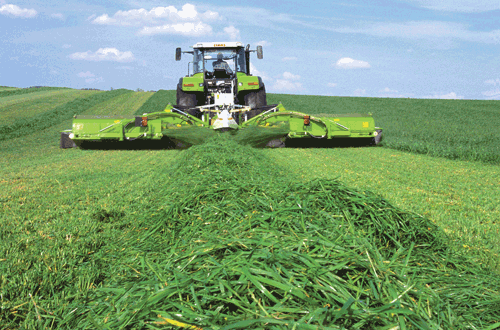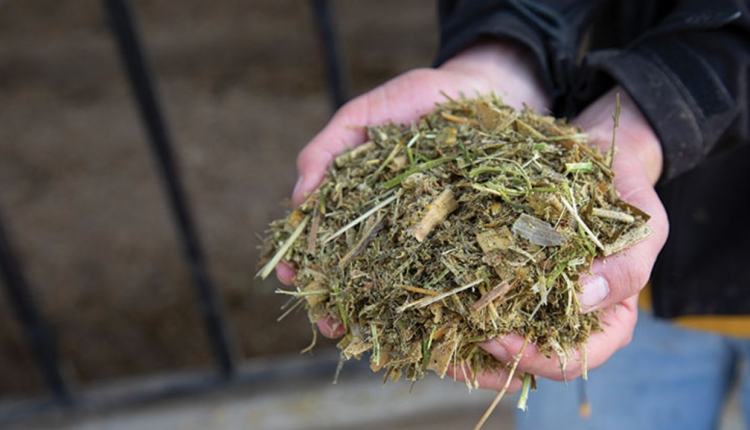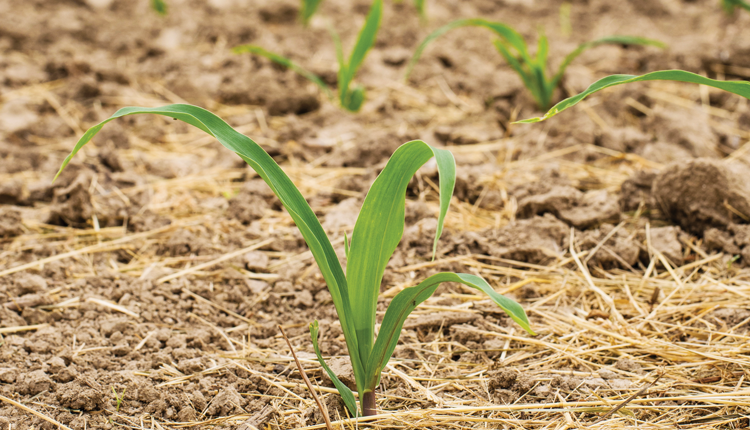The author is retired from the William H. Miner Agricultural Research Institute and now is a consultant for Oak Point Agronomics, Hammond, N.Y. 
While alfalfa regrows from energy reserves in the taproot, grass relies on nutrients stored in the bottom of the stem. Mowing grass too low can dramatically reduce yields.
Virginia poultry consultant complained to me that his lawn wasn't looking very good. He said that while he usually mows fairly high so his lawn will look green and lush, last fall he mowed it very low to make it easier to rake leaves.
In Virginia, many lawns stay green all winter. It's not unusual to hear lawn mowers running in December. But not this fellow's lawn: It didn't regrow much at all and by midwinter was looking decidedly unhealthy. Since he knew that I was an agronomist he asked: What happened?
My Virginia acquaintance isn't the only one having problems with grass regrowth: In recent years farmers in Maryland and Virginia have been complaining about poor regrowth of orchardgrass and, in some cases, even loss of the grass stand. At the same time, however, there haven't been similar complaints about poor alfalfa regrowth. What's been happening?
Disk mowers: A boon and a bane
Mowing is often the bottleneck in the hay crop silage process, especially on larger dairy operations. When disk mowers became widely available, farmers soon traded in their old sicklebars because disk mowers can be operated at a considerably faster ground speed.
In some areas, disk mowers have almost completely replaced the sicklebar. At an Ontario, Canada, meeting I participated in last year, there wasn't one farmer among the approximately 80 in attendance who still used a sicklebar mower . . . they had all made the switch. Farmers buying disk mowers quickly realized that not only were these machines a lot faster, they were much more forgiving of hitting a stone or woodchuck hole. Hitting something hard with a sicklebar mower usually means downtime to change either a guard or knife section or both. This is much less often the case with disk mowers. The result is faster mowing at shorter stubble heights, since less stubble results in more forage yield.
We know that farmers are leaving less stubble these days because the average ash content of hay crop silages has gone up dramatically. An excellent article on page 421 in the June 2005 issue of Hoard's highlighted this fact. As farmers mow closer, they sometimes scalp the soil surface, depositing soil and other debris on the windrow. Much of this is picked up by the chopper and winds up in the silage.
So why are farmers mowing hay crops closer? Because they can!
Following harvest, alfalfa regrows from crown buds. As long as the crown isn't damaged, leaving a short stubble on alfalfa has no effect on its regrowth rate or subsequent yield. Check an alfalfa field a few days after harvest: The cut stems are dead, so it obviously makes no difference if they're 1 inch or 4 inches long. The nutrients for the early alfalfa regrowth come primarily from the taproot, not the stubble.
However, grasses are much different in the way they regrow following harvest. Whether it's the poultry consultant's lawn or an orchardgrass field in Pennsylvania, grass regrows from the cut stems. And since there isn't any taproot to provide nutrients, the grass plant depends on the nutrients stored in the bottom of the stem for early regrowth. Leaving a short stubble height on forage grasses results in higher yield for that cutting but is a classic case of "robbing Peter to pay Paul."
This is one instance where theory and practice are in agreement. After a presentation I made that included the previous discussion, a Virginia farmer said that he finally understood what had been happening with his orchardgrass.
The farmer lives across the fence from a friend who also grows orchardgrass. They use a similar fertilization program and harvest their first cut at almost exactly the same time. However, the neighbor's orchardgrass has always recovered much more quickly than his did, and he couldn't figure out why. But after this discussion he understood the cause: He had a disk mower and was leaving only an inch or two of orchardgrass stubble, while his neighbor leaves several inches of stubble. The problem is serious enough that some university forage specialists are now recommending a 3- to 4-inch stubble height for orchardgrass.
A greenhouse trial at Miner Institute in Chazy, N.Y., involving first-year reed canarygrass with 2-inch versus 4-inch cutting heights resulted in a complete stand wipeout when comparing first-cut canarygrass at 2-inch stubble height to 4-inch cut grass. The reed canarygrass actually performed fine with normal regrowth when cut at 4 inches. In the same trial, orchardgrass cut at 2 inches wasn't killed, but regrowth was very slow.
Farmers often comment about how slow reed canarygrass is to grow during the seeding year. I wonder if part of this is related to cutting height, especially since farmers often close-mow the first crop of the seeding year to beat back broadleaf weeds.
What can be done
Alfalfa mowing height decisions can be based on factors other than plant nutrition. Research indicates that the greater yield resulting from shorter stubble - over the course of a growing season, about 500 pounds of dry matter per inch of stubble height - outweighs the modest reduction in forage quality. So, for alfalfa, a 2-inch stubble height is fine, perhaps slightly less than that if mowing can be accomplished without scalping the soil surface or increasing ash . . . I mean dirt levels.
In regions with cold winters, it's still a good idea to leave a high stubble on alfalfa for the last cut: 5 to 6 inches of stubble is often recommended by forage specialists. For forage grasses, however, leave a 3- to 4-inch stubble height for established stands, and, to be safe, leave a full 4 inches of stubble during the seeding year.
So much for straight alfalfa or straight grass; what about alfalfa-grass mixtures? There's little data available on this, so it's best to use common sense. In most alfalfa-grass stands, alfalfa is by far the predominant species. Therefore, manage the stand for cutting height as if it were alfalfa but no less than 2-inch stubble height. At Miner Institute, we've been aiming for 2.5 inches on mixed stands. But, if grass is a significant portion of the stand (and you want it to continue to be), don't mow at less than a 3-inch stubble height. Alfalfa and grass are simply different, and we have to treat them as if they are, not only in fertilization but also in managing plant nutrient availability during harvest.
Click here to return to the Crops & Forages E-Sources
100425_293

Virginia poultry consultant complained to me that his lawn wasn't looking very good. He said that while he usually mows fairly high so his lawn will look green and lush, last fall he mowed it very low to make it easier to rake leaves.
In Virginia, many lawns stay green all winter. It's not unusual to hear lawn mowers running in December. But not this fellow's lawn: It didn't regrow much at all and by midwinter was looking decidedly unhealthy. Since he knew that I was an agronomist he asked: What happened?
My Virginia acquaintance isn't the only one having problems with grass regrowth: In recent years farmers in Maryland and Virginia have been complaining about poor regrowth of orchardgrass and, in some cases, even loss of the grass stand. At the same time, however, there haven't been similar complaints about poor alfalfa regrowth. What's been happening?
Disk mowers: A boon and a bane
Mowing is often the bottleneck in the hay crop silage process, especially on larger dairy operations. When disk mowers became widely available, farmers soon traded in their old sicklebars because disk mowers can be operated at a considerably faster ground speed.
In some areas, disk mowers have almost completely replaced the sicklebar. At an Ontario, Canada, meeting I participated in last year, there wasn't one farmer among the approximately 80 in attendance who still used a sicklebar mower . . . they had all made the switch. Farmers buying disk mowers quickly realized that not only were these machines a lot faster, they were much more forgiving of hitting a stone or woodchuck hole. Hitting something hard with a sicklebar mower usually means downtime to change either a guard or knife section or both. This is much less often the case with disk mowers. The result is faster mowing at shorter stubble heights, since less stubble results in more forage yield.
We know that farmers are leaving less stubble these days because the average ash content of hay crop silages has gone up dramatically. An excellent article on page 421 in the June 2005 issue of Hoard's highlighted this fact. As farmers mow closer, they sometimes scalp the soil surface, depositing soil and other debris on the windrow. Much of this is picked up by the chopper and winds up in the silage.
So why are farmers mowing hay crops closer? Because they can!
Following harvest, alfalfa regrows from crown buds. As long as the crown isn't damaged, leaving a short stubble on alfalfa has no effect on its regrowth rate or subsequent yield. Check an alfalfa field a few days after harvest: The cut stems are dead, so it obviously makes no difference if they're 1 inch or 4 inches long. The nutrients for the early alfalfa regrowth come primarily from the taproot, not the stubble.
However, grasses are much different in the way they regrow following harvest. Whether it's the poultry consultant's lawn or an orchardgrass field in Pennsylvania, grass regrows from the cut stems. And since there isn't any taproot to provide nutrients, the grass plant depends on the nutrients stored in the bottom of the stem for early regrowth. Leaving a short stubble height on forage grasses results in higher yield for that cutting but is a classic case of "robbing Peter to pay Paul."
This is one instance where theory and practice are in agreement. After a presentation I made that included the previous discussion, a Virginia farmer said that he finally understood what had been happening with his orchardgrass.
The farmer lives across the fence from a friend who also grows orchardgrass. They use a similar fertilization program and harvest their first cut at almost exactly the same time. However, the neighbor's orchardgrass has always recovered much more quickly than his did, and he couldn't figure out why. But after this discussion he understood the cause: He had a disk mower and was leaving only an inch or two of orchardgrass stubble, while his neighbor leaves several inches of stubble. The problem is serious enough that some university forage specialists are now recommending a 3- to 4-inch stubble height for orchardgrass.
A greenhouse trial at Miner Institute in Chazy, N.Y., involving first-year reed canarygrass with 2-inch versus 4-inch cutting heights resulted in a complete stand wipeout when comparing first-cut canarygrass at 2-inch stubble height to 4-inch cut grass. The reed canarygrass actually performed fine with normal regrowth when cut at 4 inches. In the same trial, orchardgrass cut at 2 inches wasn't killed, but regrowth was very slow.
Farmers often comment about how slow reed canarygrass is to grow during the seeding year. I wonder if part of this is related to cutting height, especially since farmers often close-mow the first crop of the seeding year to beat back broadleaf weeds.
What can be done
Alfalfa mowing height decisions can be based on factors other than plant nutrition. Research indicates that the greater yield resulting from shorter stubble - over the course of a growing season, about 500 pounds of dry matter per inch of stubble height - outweighs the modest reduction in forage quality. So, for alfalfa, a 2-inch stubble height is fine, perhaps slightly less than that if mowing can be accomplished without scalping the soil surface or increasing ash . . . I mean dirt levels.
In regions with cold winters, it's still a good idea to leave a high stubble on alfalfa for the last cut: 5 to 6 inches of stubble is often recommended by forage specialists. For forage grasses, however, leave a 3- to 4-inch stubble height for established stands, and, to be safe, leave a full 4 inches of stubble during the seeding year.
So much for straight alfalfa or straight grass; what about alfalfa-grass mixtures? There's little data available on this, so it's best to use common sense. In most alfalfa-grass stands, alfalfa is by far the predominant species. Therefore, manage the stand for cutting height as if it were alfalfa but no less than 2-inch stubble height. At Miner Institute, we've been aiming for 2.5 inches on mixed stands. But, if grass is a significant portion of the stand (and you want it to continue to be), don't mow at less than a 3-inch stubble height. Alfalfa and grass are simply different, and we have to treat them as if they are, not only in fertilization but also in managing plant nutrient availability during harvest.
100425_293











